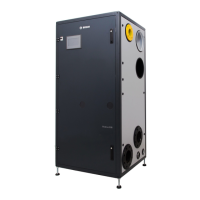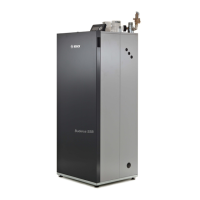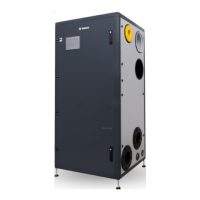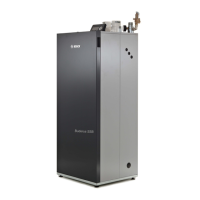6720892984 (2019/02) US SSB
26 | Main control
5 Main control
5.1 Ignition cycle (Rev 3.0.0.0)
The table below shows the states of the burner ignition cycle.
Control state Actions
Pre purge 0
Fan is not running
When an air pressure switch (APS) is enabled the APS
position is checked.
Pre purge 1
Fan starts at ignition speed
When an APS is enabled the APS position is checked
Pre ignit
Fan stays at ignition speed
Igniter is started
When a LPG tank is selected, the tank valve is opened
Ignit
Fan stays at ignition speed
The gas valve is opened
Igniter stays on
When a LPG tank is selected, the tank valve stays
opened
Flame
proving
Fan stays at ignition speed
The gas valve stays opened
The igniter is stopped
When a LPG tank is selected, the tank valve stays
opened
Burn
The fan is modulating
The gas valve stays opened
When a LPG tank is selected, the tank valve stays
opened
When an APS is enabled the APS position is checked
Post purge 0
The fan is set at ignition speed
The gas valve is closed
When a LPG tank is selected, the tank valve is closed
Post purge 1
Fan stays at ignition speed
When an APS is enabled the APS position is checked
During the ignition cycle there are multiple safety checks active.
False ame
detection
If ame is detected at the end of the pre-spark period
(
Pre ignit
) a lockout error occurs
Re-ignition
If at the end of the safety period no ame is detected
the control will go to post-purge to remove the unburned
gas. After this a re-ignition attempt is started following
the same cycle.
The number of re-ignition attempts is limited to
Max_
Ignit_Trials
after which a lockout occurs.
Flame
establishing
time
Sparking stops in the
Flame proving
state to allow
for ionization detection.
The Flame proving state takes
SAFETY_PERIOD -
IGNIT_PERIOD.
Flame out too
late
If at the end of the Post purge 0 state the ame is still
detected a lockout follows.
Flame loss
When a ame is lost during a burn cycle the control will
restart the burner. The number of restarts is limited by
the
max_ame_trials
setting.
Fan
supervision
The fan speed is continuously monitored. The following
conditions for the fan speed are checked.
• The actual fan speed must be within 300rpm of the
target fan speed
• When in the burn state both the actual and target
fan speeds are above 4200rpm, the check on the
300rpm range is not performed.
5.2 Control functions
Dependent on the required functions of the appliance and connected
sensors and components, several operation modes for Central Heating
(CH) and Domestic Hot Water (DHW) can be selected.
5.2.1 Demand for central heating (Rev 3.0.0.0)
5.2.1.1 CH Mode 0 - Central Heating demand
For this mode the CH mode should be set to 0 and no outdoor sensor is
needed.
If the room thermostat closes, the pump is switched ON. When the supply
temperature drops
CH_Hysterese_Down below the CH_Setpoint
(settable via the menu) the burner is switched ON. The power for the
burner is PID regulated between
T_Supply
and the
CH_Setpoint
using
the PID parameters for Central Heating (Also see chapter “Appendix G -
PID: Proportional-Integral-Derivative controller” pag. 59).
If the supply temperature reaches a temperature
CH_Hysterese_Up
above the
CH_Setpoint
the burner is switched OFF.
However, if
CH_Setpoint + CH_Hysterese_Up
is greater than
maximum setpoint the burner switches OFF at the maximum setpoint.
If the room thermostat opens the burner is switched OFF (if this was
not already happening) and the CH and general pumps run ON for
CH_Post_Pump_Time
.
Anti-cycling time
(This function is also applicable to all other CH modes)
When the burner is switched OFF because the supply temperature
reaches
CH_Setpoint + CH_Hysterese_Up
, the control will wait a
period of time (
Anti_Cycle_Period
¨ 180 sec. settable) before it
is allowed to be switched ON again.
This function is to prevent fast switching ON and OFF of the burner.
However, when during the anti-cycle wait time the differential between
setpoint and supply temperature gets greater than
Anti_Cycle_T_Diff,
anti-cycle
will be aborted and the burner is allowed to start.
Maximum CH power
(This function is also applicable to all other CH modes)
The maximum burner power during CH operation can be limited with
parameter
P_CH_Max
.
Minimum CH power
(This function is also applicable to all other CH and DHW modes)
• The minimum burner power during operation can be limited with
parameter
P_CH_Min
.

